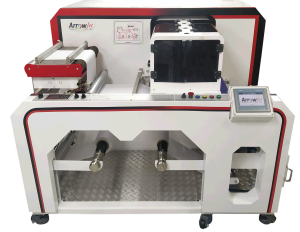Dye Based Ink Vs. Pigment Inks
The History of Ink
From cave paintings to the very first inks produced in China, ink is a very old creation that continues to improve as time goes on.
The very first printing press developed by Johannes Gutenberg used oil-based inks that prevented the press from smudging and lessened the lengthy drying time that was required by traditional inks previously used. These oil-based inks have slowly over time turned into the modern CMYK inks that we see today.
What Are Dye-Based Inks?
Dye-based inks are synthetic colorants suspended in water (sometimes alcohol or other chemicals) utilized in inkjet printers. These water-soluble inks feature saturated, vivid printed colors with low diffusion factors. They are easily absorbed into substrates and are an affordable option for everyday printing or those who’d label themselves print enthusiasts.
Why Choose A Dye-Based Ink?
Dye-Based inkjet printers feature the advantage of vivid color payoff due to the broad color palette dye inks offer. When printing plain text, the depth of blacks that the dye-based ink offers is preferred to those of pigmented inks. They adhere to numerous substrates while being affordable and easy to find.
Disadvantages of Dye-Based Inks
Inks comprised of dyes are susceptible to light, humidity and ozone wear. For these reasons, dye-based inks are lesser a choice for prints that require durability and longevity.
The reasoning for this is dye-based inks will not hold up well when they are exposed to UV light or water; as a singular drop of water can ruin an entire print. This makes them imperfect for archiving information or prints that will be exposed to direct light such as labels on container shipments.
What are Pigment Inks?
Pigment inks are composed of solid particles of pigment powders. These solid particles are less prone to smudging as the particles pigments are comprised of are larger than the smaller particles of their dye counterpart.
Pigmented inks boast longevity, preservation of color and durability. The pigment acts as a barrier to external forces such as evaporation or oxidation that dye inks are susceptible to.
What are the differences between Pigment inks and Dye-based inks?
In terms of water resistance, dye-based inks will dissolve entirely when faced with water. The water-soluble inks will easily run compared to pigmented ink.
Pigmented ink is a thicker consistency that is absorbed into the page more entirely, giving it better water resistance and making them ideal for label makers. Though no paper will be completely safe from water unless laminated, pigments have been noted to stand up more resiliently than dye.
In terms of fading, Dye-based inks being comprised of smaller molecules results in their liability to fading. The chemical reaction the dye-based inks also face when exposed to UV lighting is another reason dye-based inks aren’t holding up as well as pigmented inks in terms of durability.
Pigmented ink however is composed of larger molecules, resulting in their resistance to fading even when faced with UV lighting.
Print quality as technology grows and improves is very similar regardless of the type of ink utilized. For text-based creations, dye is ideal due to its sharp, vivid blacks and vibrant color payoff. When working with blended colors or photo prints, pigmented ink may be preferred.
Hesitancy occurs due to the fact that pigmented, water based lubricants are more expensive than dye inks. This is because they are a new technology and the production process of pigmented ink requires intensive labor time. The cost could be offset, however, in terms of using less ink per print.
Memjet Pigment Ink
Memjet Technology; also known as waterfall technology, utilizes a fixed printhead for high-speed, high-quality prints all while maintaining low costs. The redundancy of the printing nozzles reassures users that if one nozzle were to malfunction, the quality of the final print will not be impacted.
Because of the technology in the printhead and the accuracy of ink maximization, the costs overall (despite the higher cost of the pigmented ink) saves on the amount of ink used.
This in hand, ends up reducing the overall cost of utilizing pigmented ink. The results are high-quality, durable prints that boast high color payoff with longevity to stand up to whatever the prints may endure.
The ArrowJet Aqua 330R

Arrow Systems has introduced its latest digital printing technology ArrowJet Aqua 330R. It utilizes Memjet’s Duraflex technology and components to provide quality, water-resistant print labels.
This pigment-based single-pass print system focuses on economical, flexible technology that will increase the speeds, quality and lifespan of your prints.
These printheads can be stitched together to accommodate wide format printing to fit all of your printing needs.
The uses for ArrowJet Aqua-330R are various, label printing specifically is where this machine excels. Due to the pigment based inks absorbing to the label will print labels vibrantly at up to 150 feet per minute that stand up to UV wear while maintaining water resistant capabilities.
With high-speed, high-quality prints you’re capable of printing at thousands of labels per minute.
For more information on ArrowJet Aqua 330R, click the link below and forward any questions over to our website!
